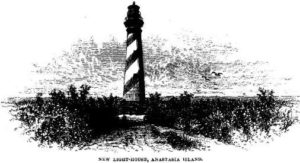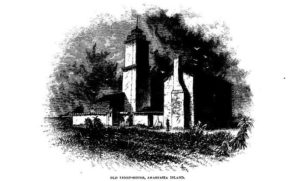Constance Fenimore Woolson, an accomplished American writer, spent winters in St. Augustine with her ailing mother from 1873 to 1879. She wove her experiences into her writing, setting several fictional stories and poems in the streets and waterways of the town. She published one such story, aptly titled “The Ancient City,” in Volumes 50 (December 1874) and 51 (January 1875) of Harper’s New Monthly Magazine. Her experiences coincided with the recent completion of, what was at that time, the new St. Augustine Lighthouse and Part One gives us a glimpse of the lighthouse and surrounding area.
The Lighthouses of “The Ancient City”
In “The Ancient City,” Woolson’s narrator, Martha, tells of her experiences in St. Augustine, including a trip out to Anastasia Island with several companions. Aboard the boat, Martha spots the “new light-house, curiously striped in black and white like a barber’s pole.” There being fewer trees and little construction on the island then, “there was nothing to compare it with, not a hill or rise of land, not even a tall tree, and therefore it looked gigantic, a tower built by Titans rather than men.”
As people have been wont to do since its construction, Martha and her companions climbed the lighthouse stairs, her view from the top similar yet different from what visitors might see today.
“The view from the summit seemed wonderfully extensive — inland over the level pine-barrens to the west; the level blue sea to the east; north, the silver sands of the Florida main-land; and south, the stretch of Anastasia Island, its backbone distinctively visible in the slope of the low green foliage.”
Although construction and progress have blurred this view somewhat, an appreciative observer will still find the “wonderfully extensive” vista from Martha’s visit. The ocean continues to dazzle while Henry Flagler’s hotels, with their own architectural splendor, interrupt the “pine-barrens to the west.” Bridges now connect Anastasia Island to the Florida mainland though observers will note the continued presence and use of many boats in the area.
Following their descent, Martha and a friend “strolled over to the old light-house — a weather-beaten tower standing almost in the water.” By this time of course, what we call the Old Spanish Watchtower was no longer operational and, as Woolson notes, inundated by ocean water. Despite its dire circumstances, the old tower would last until 1880. As narrator, Martha continues with a bit of a history lesson on the old tower.
The Old Lighthouse from “The Ancient City”
“It was a picturesque old beacon, built by the Spaniards a long time ago as a look-out; when the English came into possession of Florida, in 1763, they raised the look-out sixty feet higher, and planted a cannon on the top, to be fired as a signal when a vessel came in sight. The light that we so often watched flashing and fading in the twilight as we walked on the sea-wall was put in still later by the United States government; in old times a bonfire was lighted on top every night.”
Although sailors in need of navigational aid would prefer the more visible modern lighthouse, Martha preferred “this gray old beacon better than yonder tall, spying, brand-new tower…This is a drowsy old fellow who sleeps all day and only wakes at night, as a light-house should, whereas that wide-awake striped Yankee over there is evidently keeping watch of all that goes on in the little city.” By this time, the old dark tower stood empty, though in this story one of Martha’s companions shares an excerpt from “an old dilapidated book, written…fifty years ago” about the old lighthouse.
“We landed on Anastasia Island, and walked to the old light-house. Here a Spaniard lives with his family…Here, in this little fortified castle, Señor Andro defies alike the tempests and the Indians. Having spent an hour or two in the hospitable tower, and made a delicious repast on the dried fish which garnishes his hall from end to end, eked out with cheese and crackers and a bottle or two of Frontignac, besides fruit and brandy, we bade farewell to…the old tower…”
This excerpt likely describes the home of Juan Andreu, first keeper of the Old coquina lighthouse in St. Augustine and the first of several Menorcan lighthouse keepers. It is an interesting look at his and his family’s diet, consisting primarily of fish, which he likely procured himself from the source.
Near the end of the first part of the story, Woolson includes a poem titled “Matanzas River,” which includes the following verse.
Oh! beating past Anastasia Isle,
Where, greeting us, the light-houses smile,
The old coquina beacon, with its wave-washed walls,
Where the spray of the breakers ‘gainst the low door falls,
The new mighty watch-tower all striped in black and white,
That looks out to sea every minute of the night,
And by day, for a change doth lazily stand
With its eye on the green of the Florida land,
And every thing doth spy —
E’en us, as we sail by.
Come see the “wonderfully extensive” view Woolson wrote about and admire it for yourself!
Paul Zielinski is Director of Interpretation for the St. Augustine Lighthouse & Maritime Museum. He received his master’s degree in Public History from the University of West Florida and joined the lighthouse family in 2011.



